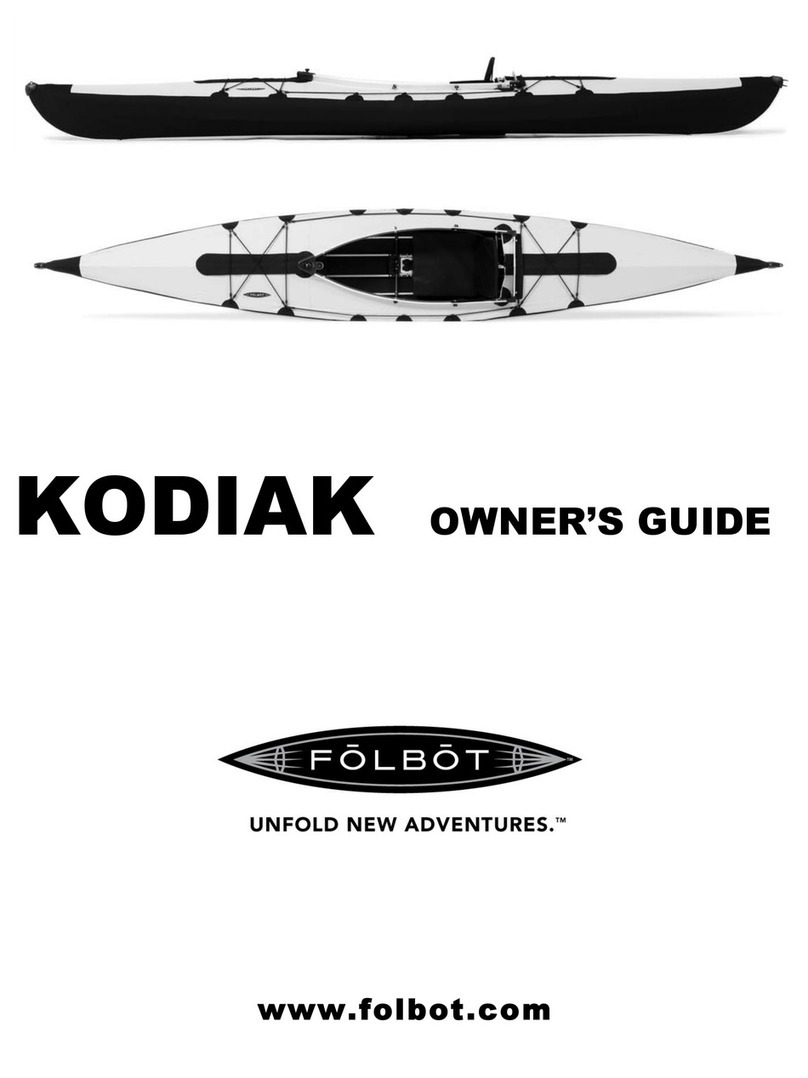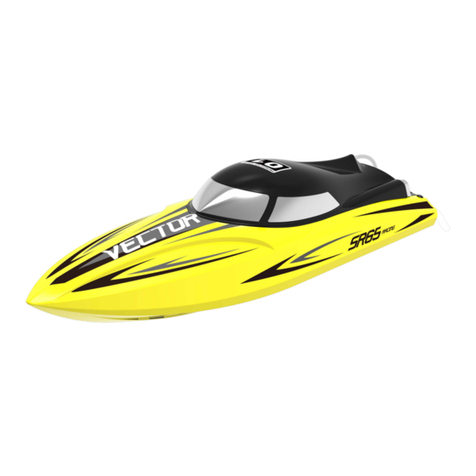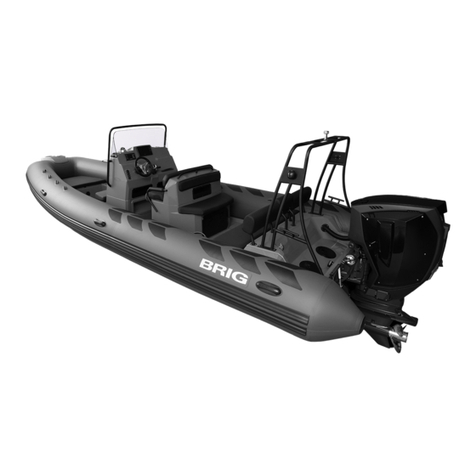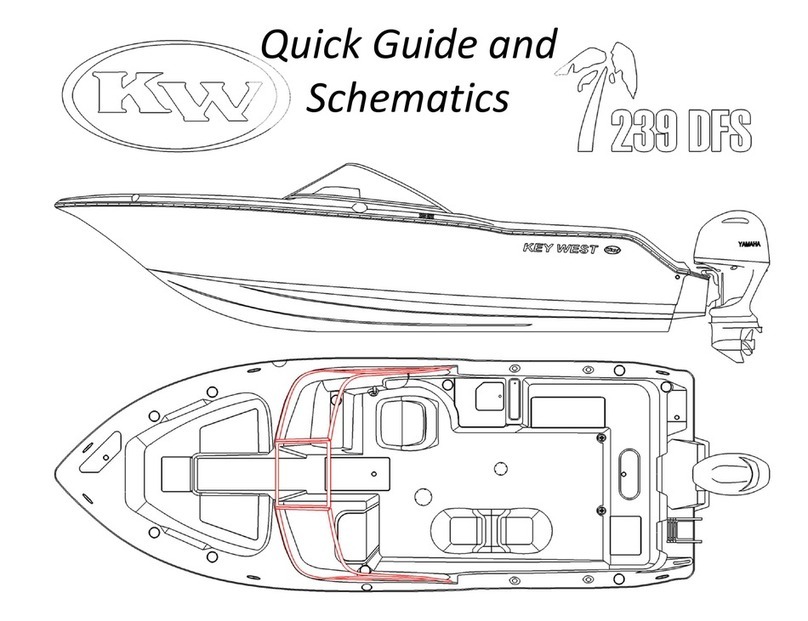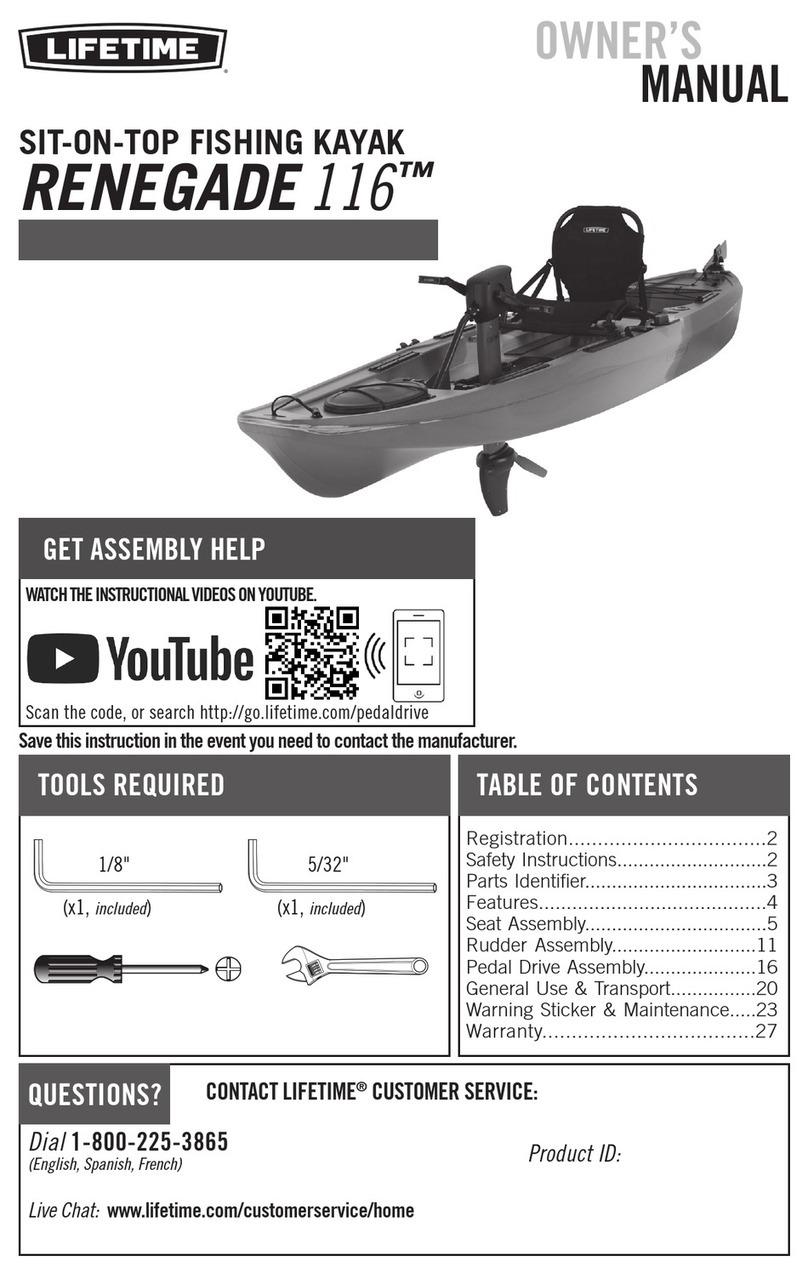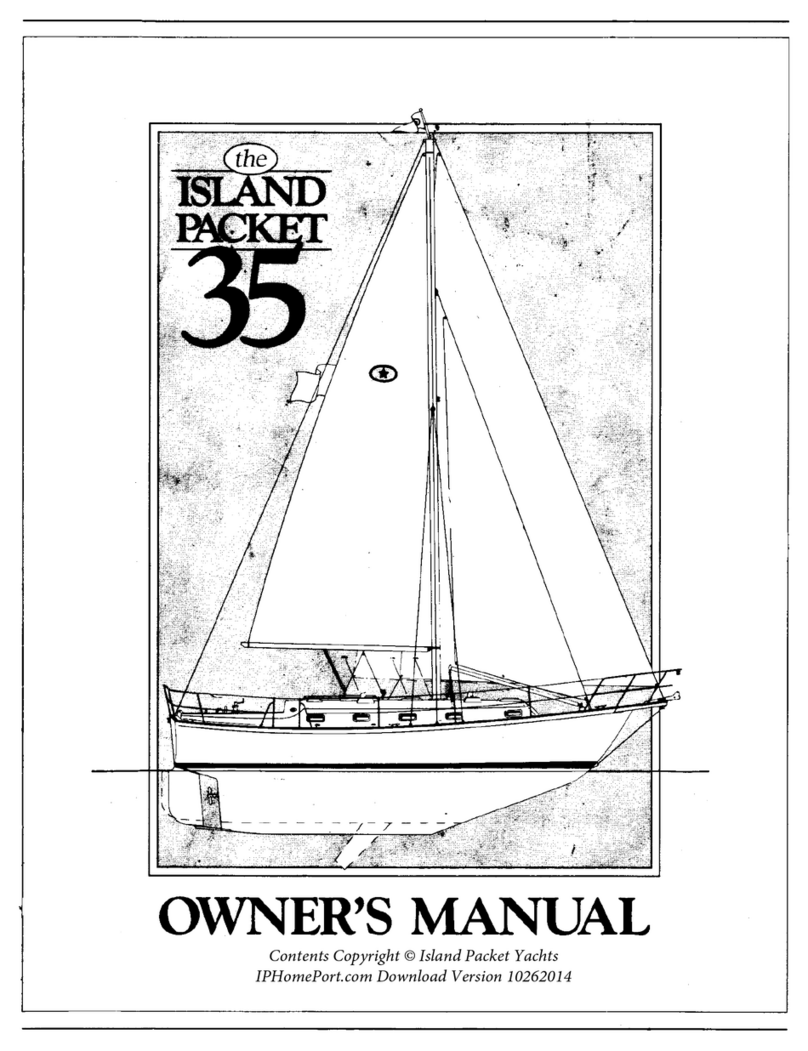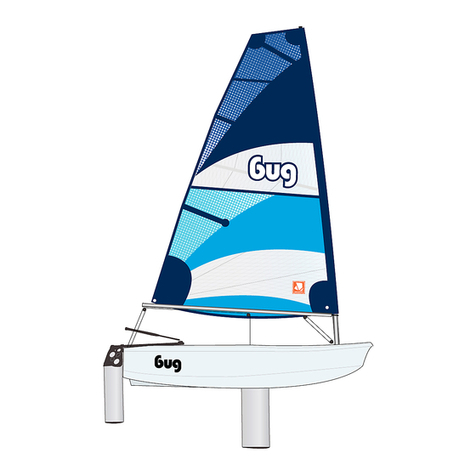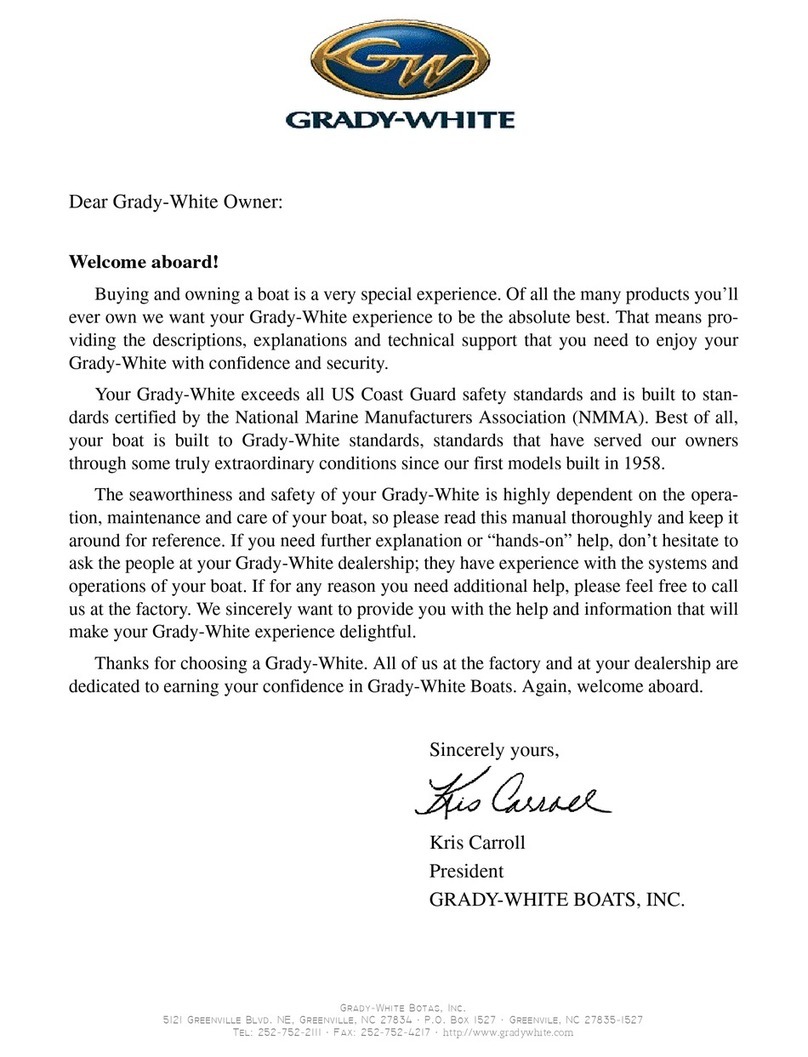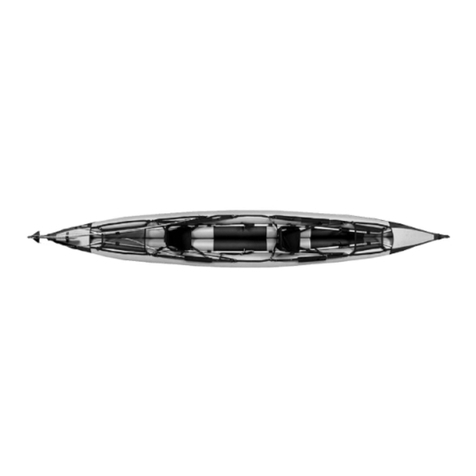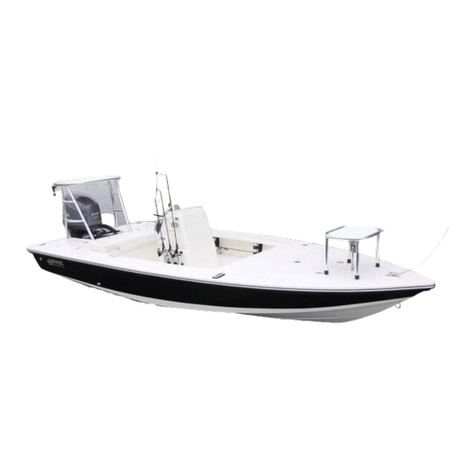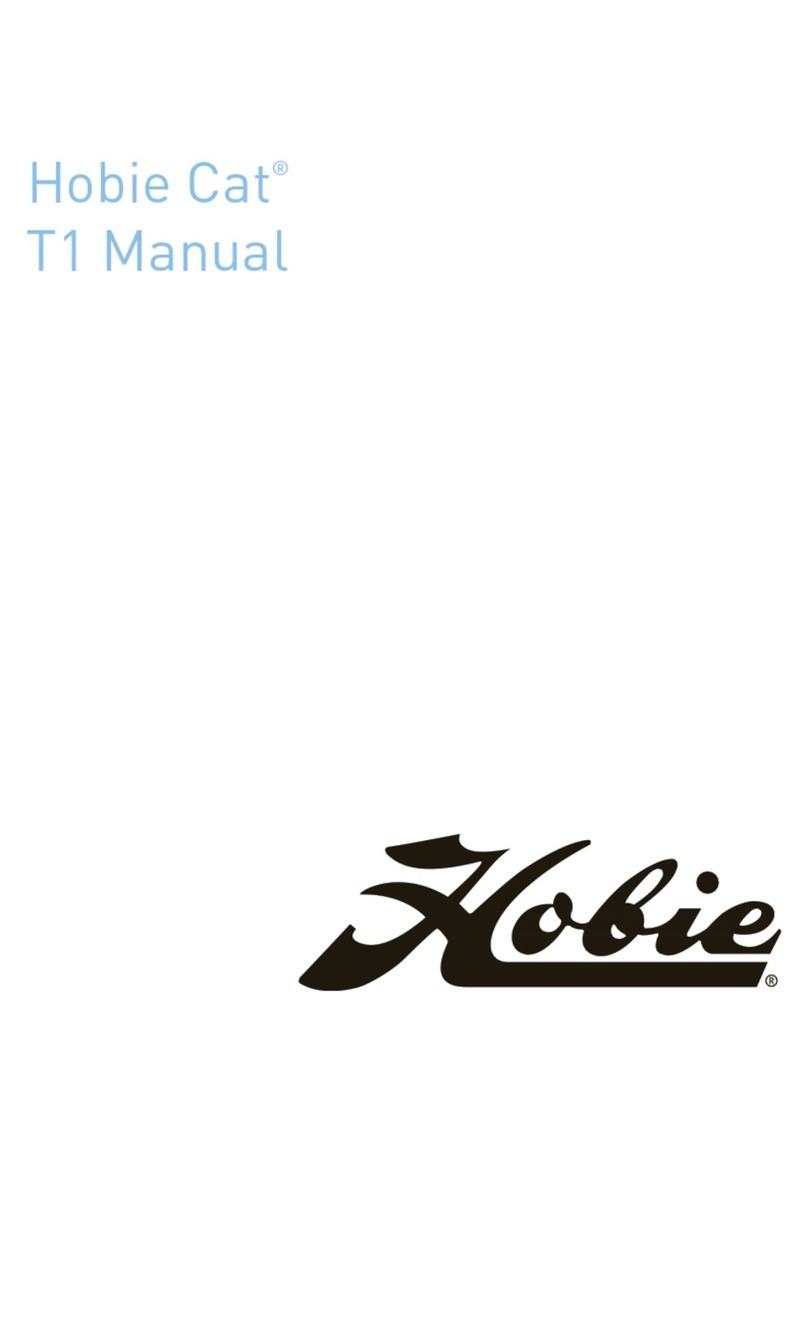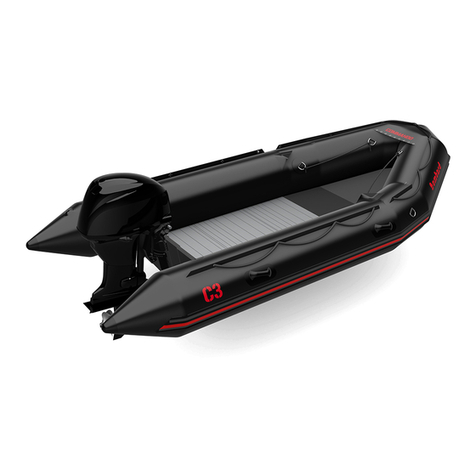folbot Citibot User manual

Citibot
OWNER’S GUIDE
www.folbot.com

Page 2 of 12
FOLBOT OWNER’S TIPS
ADDING YEARS TO YOUR FOLBOT’S LIFE
1. As you become familiar with the assembly of the boat, pieces will fall into place naturally. Allow plenty
of time for the first assembly and enjoy the process. Avoid forcing any parts as you are learning.
2. Should you experience any difficulty in assembly, please check with us at the factory: 800/533-5099,
8:30-4:30 Eastern Time, M-F.
3. If using the boat extensively in salt water, there are several things you can do ahead of time to
eliminate maintenance later: sliding parts that are shock-corded together should be sprayed occasionally
with silicone spray. After use in salt water, disassemble the boat, rinse all parts with fresh water, allow to
dry, and reapply silicone. This will prevent oxidation and sticking of these parts.
4. Sand should always be rinsed out of the boat thoroughly when disassembled. Sand can hinder the
operation of the lower shock-corded joints and the tensioning mechanism, so care should be taken to
ensure that they are rinsed free of sand after use.
5. While the fabrics used on both the deck and hull are very ultra-violet resistant, protect the boat from
sunlight when not in use.
USING YOUR FOLBOT
1. Take a little extra care when launching your kayak. Though the hull fabric is tough, you should not drag
a boat from the shore into the water. Launch from a bank or dock if possible. If not, carry the kayak into
the water until the bottom clears and it floats. Use this procedure when landing also. It will add years to
the life of the hull.
2. You may step on the tubing or the fabric when entering the boat. Stay low and grasp the washboards as
soon as possible and lower yourself into the seat. This is a learned skill and you will become very adept
at this with a little practice.
3. It is possible to enter the boat from the water, but this requires some practice. A wet entry should be
practiced in shallow water to determine your ability to re-enter the boat. Entering the boat from the bow
or stern requires a bit of dexterity as you slide across the bow or stern deck into the cockpit. Using a
paddle float properly will enable you to enter the boat more easily, but lessons in this procedure should
be taken.
4. The proper paddle length for a kayak is determined more by the beam (width) of the boat than any
other factor.
5. The basic kayak paddle stroke is unlike that used to paddle a canoe. Rather than reaching straight
down into the water, the kayak paddle enters the water at about a 45-degree angle. Rather than pulling
the blade through the water with the arm closest to the submerged paddle blade, that arm remains
straight and stiff and becomes a fulcrum while the other arm pushes, much like a boxer’s motion.
6. A gradual turn can be accomplished by paddling only on one side of the kayak. A sharper turn is made
trailing the paddle at an angle, just like a rudder. An abrupt turn can be achieved paddling forward on
one side of the kayak and then quickly backwards on the opposite side.
7. If the boat has capsized, it is best to stay with it and swim it to shore before attempting to empty it of
water. Emptying the boat should be done by gently rocking it back and forth toward a position where the
boat is on its side, and then rolling it completely upside down. If it is impossible to get a capsized boat to
shore, it can be bailed with an open container or bilge pump, but this is quite time consuming. Safety
bladders or float storage bags are recommended. The larger the safety bladders, the better, as less
water can enter the boat.

Page 3 of 11
8. A foot rudder is best used when paddling in large, open bodies of water, particularly when it is
necessary to counter a cross wind or cross tide. You can usually make a sharper turn with the paddles
than with a rudder.
9. Avoid towing the Folbot behind a powerboat. Because of its light weight when empty, it is quite easy to
flip the boat at high speeds. In an emergency, tow it at an idle, and leave some small amount of weight in
the boat.
AFTERCARE OF YOUR FOLBOT
1. It is very important that your boat be completely dry when it is packed away for longer than a day
or two. As soon as convenient after using, allow all parts to dry thoroughly before storing in the bag.
2. The hull fabric is easily repaired using a service kit available from our factory. Detailed instructions
are included with the service kit. Generally a small nick in the bottom layer of the hull that does not
penetrate the fabric is best ignored or touched up with clear Aqua Seal or Shoe Goo, a material sold at
sporting good stores for mending tennis shoes. Any hole that goes completely through the fabric should
be patched following the instructions included with the service kit.
3. The hull and deck can be cleaned with soap and warm water as needed.
4. The deck is made of urethane-coated polyester and is quite UV resistant. The deck fabric can be
patched from the underside if it is ever damaged using a fabric patch and contact adhesive.
MISCELLANEOUS TIPS
1. Car-topping a setup boat is fine, but the boat should be secured across the body of the boat rather than
from the bow and stern. A light line can be run from the bow of the boat to the front bumper or other
attachment point on the front of the vehicle to prevent weathervaning. Use V-shaped foam pads under
the hull of the Cooper or kayak cradles that are available for most racks.
2. When paddling in very cold water, your legs will stay warmer if a thin foam pad, such as used under
sleeping bags, is spread out on the bottom of the boat.
3. When carrying your boat as baggage aboard a commercial airline, no additional protection should be
needed. A small lock should be used to lock the zipper pulls or at least the zipper pulls tied together.
4. While we are happy to make repairs or solve problems you may have with your boat, items can often
be cured by the owner without having to send the boat back to us. Call us before shipping a boat back to
be sure we don’t have an easy solution.
5. If you plan to roll your Folbot or bury the gunwales frequently to
turn abruptly, we suggest you apply a thin coat of Seam Grip sealant
to the joint between the deck and the hull on the inside of the skin.
Simply brush the sealant onto this seam from bow to stern, one side
at a time. Drying time requires that you do this in two different
applications, allowing each side to dry overnight without coming in
contact with other surfaces.
Remember: we are here to help if you need us!
Call 800/533-5099, 8:30-4:30 M-F Eastern Time, or visit www.folbot.com

Page 4 of 12
ASSEMBLY INSTRUCTIONS
Before assembling your Folbot, take time to familiarize yourself with all the parts and the terminology
used. You should find the following contents when you unpack your boat for the first time.
4 bundles of longerons — Each longeron bundle is four pre-bent sections shockcorded together. The two
upper sections (called gunwales) are identified by red dots on the ends and have Velcro attached, and the
two lower sections are identified by green dots.
2 gunwale extenders — These will slide into the open end of the gunwale longerons.
1 rear duck strut — Made up of one section of tubing with a black tube eye mounted to one end.
1 bow deck strut — Made up of two sections of tubing shockcorded together, and identified by a blue dot.
1 stern keel tensioner mechanism — A curved member with a threaded nylon rod and yellow hand wheel.
1 bottom keel bundle of longerons — This bundle consists of a curved section shockcorded to four
sections of bottom keel (labeled #1 through #3).
3 crossframes— Anodized black and numbered #1 through #3.
1 seat— Black anodized two-piece frame with cushioned bottom and backrest attached by Velcro.
1 cockpit frame — Oval-shaped aluminum tubing identified by the spiraled Velcro.
1 boatskin — Note how the boatskin is folded so you can put it back into the bag correctly when
disassembled.
2 yellow inflatable sponsons (about 10 feet long) with Velcro on one side of each.

Page 5 of 12
To assemble the boat you will first complete the frame, not including the seat assembly.
The frame is then inserted into the skin and the stern end expanded until the skin is
tight lengthwise. Please read all the instructions, and assemble slowly and carefully the
first time.
1. Begin by checking the contents of the bag to be sure all parts are present.
2. Locate the bundle of tubing consisting of the curved bow end and the bottom keel. Engage the shock-
corded joints on these pieces to form a straight bottom keel. Lay this assembly on its side.
3. Locate the bow deck strut. Connect the shock-corded joint, and then snap the end with the blue dot
onto the short tube (also marked with a blue dot) fixed to the top of the curved bow end. Ensure the snap
button engages the hole.
4. Now assemble the two upper longeron (gunwale) bundles, identified by the red dots. These are pre-
bent at the factory and may look strange until the crossframes are in place. There will be a right and left
gunwale, and they are correctly positioned when the Velcro is on the outside edge of the boat and the
Velcro ends each match the position of the adjacent tube.
5. Join the gunwales to the curved bow end and
bottom keel assembly. These go on the top
butterfly fixtures next to the red dot on the curved
portion of tubing, with the screw head facing up
(see photo at left).
Depress the snap button at the end of the gunwale
and move the 3” slider back to expose the slot in
the black molded end. Slide the slot onto a wing of
the butterfly fixture from the side, so that the
screw is in the cutout of the wing. Move the slider
back in position until the snap button pops up.
Turn the assembly on its other side and join the
second gunwale in the same manner.
6. Repeat this procedure with the lower longeron bundles, identified by the green dots. These longerons
attach to the lower butterfly fixture, also marked with a green dot. Position the deck strut so that it points
forward and is out of the way.

Page 6 of 12
7. Locate crossframe #1. This frame must be
oriented properly so that the black crescent-
shaped clips on the crossframe mate the gunwale
tube at the proper angle. Reverse the frame if this
is not the case. Locate the #1 on the bottom keel
and snap the bottom clip onto the bottom keel
between the locator clips (see photo at left).
Now clip the gunwale longerons into the upper
corner clips on both sides of this crossframe.
Repeat by clipping the lower longerons to the
remaining clips.
Fasten all Velcro cinch straps by running them
through the buckle and back onto themselves.
8. Locate crossframe #2 and repeat the above procedure by first attaching to the bottom keel, then
snapping the gunwale longerons and lower longerons in place. Now fold back the deck strut and snap
into the uppermost clip on crossframe #1. Remember to fasten all cinch straps as above.
9. Repeat with crossframe #3. Remember to orient
it correctly as in the previous step. Note that the
crescent-shaped clip on the bottom of crossframe
#3 does not go between two locator clips as with
the other two frames, but up against the aft end of
the section of larger diameter tubing that is
riveted to the bottom keel near the end (see photo
at left). Also note that the riveted section of the
larger diameter tubing should be facing up into
the boat.
10. Now that all crossframes are in place, locate
the rear deck strut (the short piece of tubing with
the black deck eye on one end) and fasten it into
the black clip on top of crossframe #3. The open
end of the deck strut should face the stern of the
boat and be about even in length to the bottom
keel.
11. Now it’s time to adjust all locator clips on the gunwales and bottom keel. Beginning at the bow and
working your way toward the stern, twist each section of tubing so that the locator clips are facing the
inside of the boat. Each section can be adjusted separately because of the moveable shockcorded joints. It
is important that the locator clips do not show through the deck fabric when the boatskin is in place.
12. Locate the tensioner device, consisting of a section of curved tube, a threaded nylon rod, a yellow
hand wheel and an aluminum channel piece. Slide the tubes of the tensioner into the rear deck strut and
bottom keel. Note that the top tube on the tensioner is slightly longer than the lower tube, so you should
insert it onto the deck strut first. Now slide the tensioner forward as far as it will go.
13. Find the two gunwale extenders and slip them into the open end of the gunwale longerons at the
stern. The snap button does not go into a hole but is there just to keep the gunwale extenders from
falling out and getting lost.
14. If you ordered foot braces with the Citibot, now is the time to install them as well. They are much
easier to access and adjust before the frame is in skin.

Page 7 of 12
15. Locate the cockpit frame, which is wrapped in
spiraled Velcro on both sides. The more pointed
end will be installed toward the bow of the boat,
with the squared off end toward the stern. Both
ends of the frame should also sweep up.
Begin by connecting the bow deck strut to the bow
end of the cockpit frame (see photo at left). The
strut mounts to the top of the cockpit frame using
the bolt and star knob attached to the strut. The
knobs must be placed on the inside of the boat.
Use this same procedure with the rear deck strut.
Note that the rear deck strut can slide back and
forth so that the holes at both ends of the cockpit
line up with the tube eyes on the deck struts.
16. Now press the sides of the cockpit frame into
the clips on top of crossframe #2. Secure the frame
by running the Velcro cinch straps through the
buckle and back onto themselves.
17. Find the two yellow inflatable tubes (sponsons)
with Velcro on one side. There is a right and left
sponson in the set, which are each positioned so
that the inflation tubes enter the cockpit of the
boat ABOVE the gunwale and point toward the
rear of the boat. These sponsons are pressed in
place against the mating Velcro attached along the
length of the gunwales (see photo at left).
At this point, the frame is almost complete except
for the seat. Way to go! Take a break and admire
your work. Parts now remaining are the boatskin
and seat.
18. Unfold the boatskin and lay it out as flat as possible, with the deck side up (note the bow of the skin
has a Folbot patch sewn in place and no zipper). Unzip the stern zipper and lay open the skin from the
cockpit to the stern end.
19. Pick up the frame, and with its bow pointing toward the bow of the skin, slip the nose of the frame
into the cockpit opening and gently slide it into the skin. Watch that the frame does not hang up on
anything. You may need to stretch the skin lengthwise. The frame should go all the way into the skin until
you can feel the curved bow end through the end of the skin. You may find it easier to pull the cockpit
opening in the skin over the cockpit as much as possible and sliding the frame further forward.
When this is complete, check to see if the skin appears centered on the frame. One place to check is at the
cockpit nose; another is at the seams between the hull and deck. Each side should be equal to the other
side. If the skin is not centered, you can slide the frame out just a bit and work the skin into a centered
position.
20. Now find the inflation tubes going to the yellow side sponson tubes and free them from underneath
any frames and longerons.
21. When you are satisfied that everything is centered within the boatskin, go to the stern of the boat and
stretch the skin as tight as possible while holding the frame in position. You should now be able to get the
stern end of the frame into the stern end of the boatskin with the zipper fully opened. If not, stand behind
the boat facing toward the stern. Hold the frame with one hand and grab the black webbing loop of the
boatskin with the other. Tug the loop gently upward until the frame fits into the skin.

Page 8 of 12
22. Zip up the rear deck, again making sure
everything is centered. If not, with the zipper
open, you can exert force on the skin (as shown in
the photo at left) to move it in the direction it
needs to go.
Please read the next few steps carefully!
23. With the rear zipper unzipped, reach into the boat and slide the tensioner assembly as far toward the
stern as possible—about two or three inches. Place the black tube eyes, which are mounted on the
aluminum channel of the tensioner assembly, onto the ends of the lower longerons (the photo above
shows this part in position, but was taken out of the boatskin for clarity). The tube eyes just slip onto the
ends of the lower longerons.

Page 9 of 12
24. Reach in through the zipper and turn the
handwheel clockwise, and continue to turn until
the skin is tight lengthwise. You may need to pick
up the stern of the boat and give it a few shakes
before tightening a bit more. You do not have to
use up all of the threaded rod.
The handwheel will turn more easily after a few
uses, or you can try giving it a light coating of
silicone spray.
The more tension applied to the skin with the
handwheel, the fewer wrinkles there will be in the
skin and the stiffer the finished boat.
25. Once you have tensioned the skin sufficiently, pull out the telescopic gunwale extenders in the end of
the gunwale longerons. As in step #5, engage them to the butterfly brackets on the stern end of the frame.
Now zip up the rear deck, making sure the zipper is centered along the rear deck strut.
26. Now at the cockpit, locate the Velcro flaps
sewn around the inside of the cockpit fabric. Pull
these flaps over and around the cockpit frame,
pressing the Velcro surfaces together. Note that if
you want to add more tension to the skin at this
point, you must first loosen the Velcro flaps and tuck
them under the cockpit frame. Leave the two Velcro
flaps at the rear of the cockpit loose until you have
finished the coaming assembly.
27. Unzip the rear deck zipper about 1 foot (see photo at left). Within the cockpit coaming, you will find a
black plastic tube that has a section of smaller aluminum tube in it. With the zipper open slightly, insert
the aluminum tube into the open end of black tubing to complete the circle. Now zip up the rear deck all
the way and secure the two Velcro flaps.
28. Locate the seat frame. With it folded in the
seating position (90 degrees), you will see three
black crescent–shaped clips facing down.
Insert the back of the seat frame into the cockpit
first so that you can get the silver-colored bar at
the top of the seat back UNDER the cockpit frame
(see photo at left). Now engage the clip attached to
the bottom of the seat back frame to the bottom
keel.
Move the seat bottom toward the stern of the boat,
which will raise the rear of the cockpit coaming as
you go. When it is back far enough to match the
two remaining clips with crossframe #2, the seat
can be snapped down in front.

Page 10 of 12
Place the seat cushions in the seat frame, using the strap on the cushion back over the back frame and the
Velcro tabs on the seat cushion bottom to the mating Velcro on the bottom frame. You can vary the
firmness of the bottom cushion and lumbar pillow by adding or releasing air.
29. Inflate the side sponsons by blowing into the inflation tubes. The deck will stay centered on the boat
frame if you blow some air into one side and then the other, repeating this process until the sponsons are
as tight as possible. Creaking noises are normal as the skin becomes stretched by the sponsons. Close off
the tube valves by turning them clockwise. Look inside the boat to be sure that the sponsons have
remained centered along the gunwale, with inflation occurring on both sides of the gunwale.
30. Hook the deck bungees across the deck in an X pattern. The ends with the closed clips should remain
connected, while those with the open clips can be taken off and on as needed.
31.When opening and closing the deck zipper for access to gear, etc., air should be let out of the sponsons
until the deck fabric is not drum tight.
32. Disassembly of your Folbot is the reverse of this procedure, but here are some helpful tips:
Always disconnect the telescopic gunwale extenders first. When loosening the tensioner assembly, turn
the handwheel counterclockwise just enough to free the aluminum channel with the black tube eyes from
the lower longerons (about six turns). This will help free up the skin from the frame.
Be sure the Velcro flaps have been peeled back and tucked under the cockpit frame.
Fold the boatskin up as follows:
1. Tuck the deck fabric into the hull fabric with the hull laid out on its side, full length.
2. Fold the keel ends in toward the cockpit and then fold again right up against the cockpit
coaming so the skin is divided into four parts.
Always make sure the fabric is dry before folding it up! If this is not possible, reassemble the boat at the
next available opportunity and allow it to dry out.
When packing your Folbot back into its bag, the seat, folded flat, should go in first with the cushions in
place and against the side of the bag that has the harness. The folded boatskin should go in second.
Generally speaking the crossframes are stacked so that the smaller frames are placed within the larger
frames. Longeron bundles should go in last. There is also room for the paddle. Some trial and error may
be needed to determine the best fit and nesting arrangements.
It should be noted that you can get more in the bag than it first appears. Don’t give up until you’ve tried to
zip up—you will be suprised at what can fit in!

Page 11 of 12
NOTES

Page 12 of 12
Table of contents
Other folbot Boat manuals
